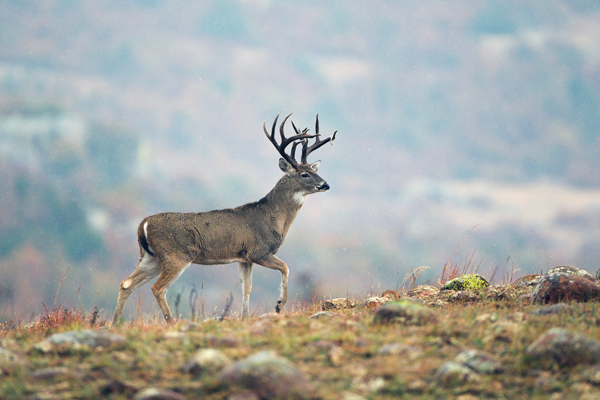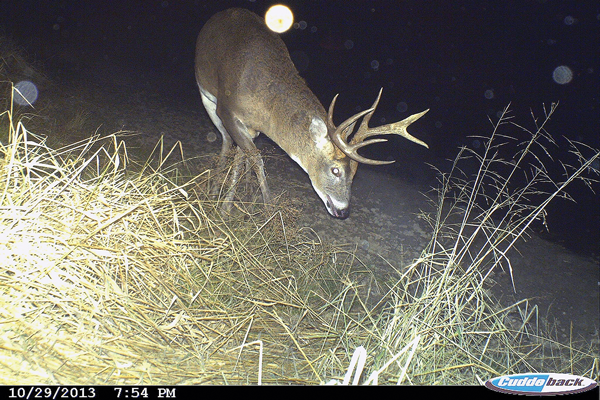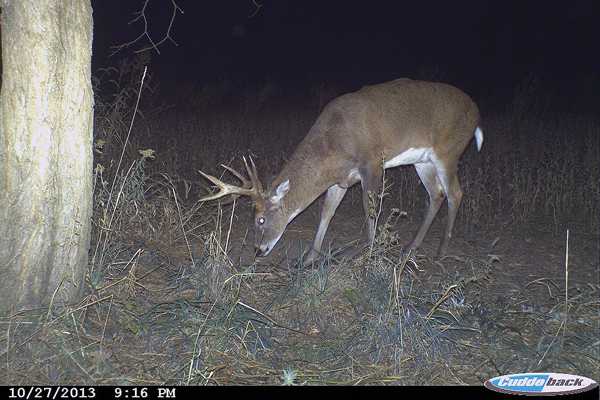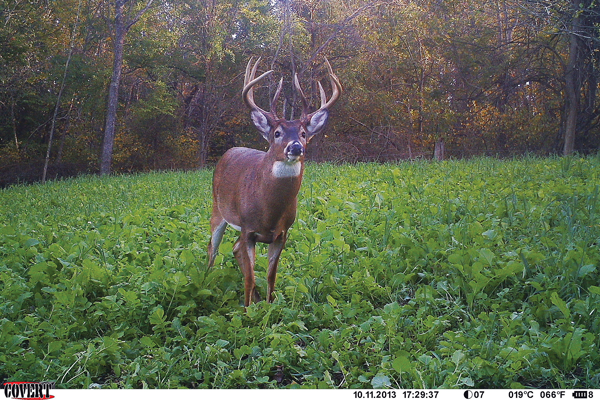October 18, 2016
By Bernie Barringer
I walked into the fertilizer company's office just in time to hear the radio crackle, "Bernie, are you there yet?"
I was showing up for work just after daylight that mid-November morning in 1989, and my boss was already asking for me on the radio. But when I answered, the call took on a whole new meaning.

"I'm by the slough on the southeast end of Paul Johnson's home place. GET DOWN HERE NOW!"
Advertisement
Jerry was also my bowhunting buddy, and I knew what the call meant. It's illegal to share hunting information over the radio, but I could tell by the urgency in his voice that this call wasn't exactly work-related.
Jerry often showed up for work late at that time of year because he spent a couple hours each morning glassing the surrounding farmland for bucks that had pushed does out into the open fields. This morning, he needed help — and I was happy to oblige.
Ten minutes later I skidded to a stop next to his vehicle on the gravel road. With our windows down, he excitedly related what had prompted his radio call.
Advertisement
A "huge," "giant," "monster," "unbelievable" buck had seen Jerry's truck top the hill and had dived into tall cattails and willows, disappearing into the 1-acre slough. The buck was still in there, and Jerry was going in after him. My boss would give me a few minutes to work around and choose an escape route to cover in case anything went wrong with his stalk.
Taking note of the wind direction and assuming the buck would try to sneak out with the wind in his nose, 10 minutes later I was covering a deer trail on the opposite side of the small patch of cover. Jerry began creeping in. Arrow nocked, release on the string, I was ready. I still hadn't seen the buck, but Jerry and I had hunted a lot of these northern Iowa bucks in similar situations, and I could tell by his wide-eye description of the deer that this wasn't just another 150.
Moments later, I heard Jerry yell. I stood up just in time to see the buck escape the far side of the cover and run across the field. I got a good, long look at him as he ran through the CRP field and over the crest of a hill. And what I saw defied description.
To this day, the sight of that buck is etched in my memory. In 45 years of bowhunting, I've never seen anything else like him. His rack was twice as wide as his butt. It reached for the sky, and my first thought was that he had a rocking chair on his head. Stickers and kickers and drop tines: this buck had it all.
Despite spending the remainder of that day and many hours over the following weeks and even years trying to locate the buck, we never saw him again. We never heard of him being killed. We never even heard of anyone else around there having seen him.
So, to our knowledge he was never killed. When we'd look at replicas of world- and state-record bucks, including the giant 282-inch Raveling buck at the Iowa Deer Classic, Jerry and I would just shake our heads and sigh.
Where did that giant we saw come from? Where did he go? How does a world-class buck just appear out of nowhere — and then disappear just as mysteriously?
An Old Theory Revisited
In 1993, Tom Miranda and I teamed up to write a book called Corn Fed Giants. In it, we offered a lot of information for the farmland whitetail hunter. Among the topics I wrote about in the book is a phenomenon I've not seen in print anywhere else.
I wrote of my belief that once an outsized, genetically superior buck gets big and strong enough to beat up every other buck he contacts, he just goes wherever he wants during the rut. He breeds does as he pleases, traveling far and wide if need be in that quest. He might follow long-running travel corridors for miles and miles. Then, when the rut is over, he might return to his original range — or, he might settle down right where he is, in the best available habitat.

When I announced that theory over 20 years ago, researchers' ability to track wild bucks' movements wasn't what it is today. Now, with GPS collars, a lot more has been learned about travel patterns and home ranges. Even so, I don't believe there's been any research to back up my theory.
In fact, most research has shown bucks tend to reduce their home ranges they mature, particularly after passing peak breeding age. But I'm not totally ready to give up on trying to explain the issue of bucks that appear and disappear like ghosts.
One thing we've learned is that bucks are individuals with their own "personalities." And to my knowledge, no one has put a tracking collar on a wild, world-class buck in Midwest farmland habitat. I've seen too many situations in which a huge buck just showed up on a camera, never seen before and then never shot or even seen again. Nor is either of his shed antlers found. It's as if he simply appeared out of thin air . . . and then vanished in the same fashion.
What does this mean to the hunter who wants to know more about the home ranges and travel patterns of mature whitetails? And furthermore, is there information out there to help us improve our odds of bringing such deer home with us?
Defining Home Range
Every deer hunter has heard the term "home range." It's usually associated with a number of acres or square miles. The numbers vary greatly by terrain, habitat quality, food availability and time of year.
Home ranges of whitetail bucks in excellent habitat with plenty of food available can be quite small. GPS studies in prime areas of Louisiana, Pennsylvania and Maryland have shown home ranges averaging from 269 to 559 acres; not even as much as a square mile (640 acres).
Often a square mile is used as a baseline for a buck's home range in good habitat, though there are clearly many places in which that figure is way off. A GPS tracking study in Texas showed an average home range of 2,271 acres. Availability of food and proximity to cover make all the difference.
In many parts of the West, in fact, whitetails routinely make treks of 2-3 miles between preferred bedding areas in timbered hills to feed on alfalfa in the lowlands. The deer make that long-distance hike each way daily. It's hard to put a number of acres on a home range when deer are taking such long strolls.
Putting a number of acres or square miles on a home range is deceiving, because it almost implies the area is something of a circle or square. In reality, a home range might be a section of winding river bottom two miles long by 300 yards wide. It might include a couple areas where the deer move upstream on a small tributary, which further makes putting a number on it difficult. The shape of a deer's home range is dictated by habitat, not by acres.
It can be a mistake to get caught up in home ranges when targeting a particular deer. Trail cameras can help you get a feel for where the buck is spending the majority of his time and when he's there, but trying to determine the boundaries of his preferred area can be futile.
Bucks will go wherever they need to go to get food and water daily, and they'll certainly roam during the rut. Home ranges are very fluid and dynamic.
Core Areas
While an overall home range might be pretty nebulous, a core area isn't. The Quality Deer Management Association defines a core area as "The portion of a buck's home range where he spends 50 percent of his time." Core areas are all about security and comfort. While a buck might range widely to find food and water, he'll often come back to the same small area in which he feels secure.

These core areas can change due to weather and food availability. If a food source completely runs out, and there's suitable bedding cover near a new food source, the buck might pack up and move.
Bucks also tend to bed in the thickest, nastiest cover during bad weather, though they tend to select areas with some visibility during pleasant weather. A buck might use three or four core areas during the course of any given year.
On average, mature bucks tend to have smaller core areas than younger bucks. The 2 1/2-year-olds travel widely, having ranges much larger than even 3 1/2-year-olds.
Many bucks 5 1/2 or older have tiny core areas in which they've learned they can feel secure. These deer are big enough to take over the best of the best bits of security cover from other bucks if they so desire.
Excursions
The ability to track bucks' exact whereabouts with GPS technology has opened a whole new world of information about their habits. One of the things learned through these studies is that bucks, especially mature bucks, take off on what biologists have termed "excursions" a few times per year. The GPS collars have shown these to be anywhere from one to four miles from the core area.
These trips often last around three days. It's no stretch, considering the individuality of bucks, to suggest some are far longer. The "stranger" that just showed up on your camera might be on just such an excursion.
While the rut is one time in which bucks make excursions, it isn't the only one. Spring also is "vacation time" for many bucks. In a GPS study done in Pennsylvania by the University of Georgia's Andy Olson, all 19 collared bucks went on spring excursions.
It's not fully known what triggers such forays, but some likely are the result of nutritional needs as antlers are beginning to grow. This also is the time when many bucks approaching their first birthdays are traveling around, looking for adult home ranges of their own.
Fall excursions might be related to rutting behavior or even hunting pressure. The collared bucks in these studies were quick to go entirely nocturnal when they felt hunting pressure or other human intrusion. Pressure even can cause bucks to leave their home ranges altogether for long periods of time.
Secondary Ranges
Following buck movements by GPS makes it clear most bucks have a backup plan: a secondary home range they'll move to as needed. This is evidenced by the fact they tend to go directly to new areas and spend a lot of time there, indicating prior knowledge of those places.

I have no way of proving this, but I theorize these secondary ranges are often bucks' natal areas. A buck spends the first year of life in his mother's home range, learning it intimately. It stands to reason that if an adult buck is making a beeline to an area he knows well, it's possibly one he learned as a fawn.
I suppose the only real way to prove or disprove my theory would be to put a GPS collar on a wild buck fawn and track him over several years. To my knowledge, this hasn't yet been done.
In Conclusion
Keep in mind that only a relatively small number of wild bucks have been collared and tracked for lengthy periods. This leaves us with very general tendencies and few specifics.
Again, bucks are individuals; they often have remarkably different habits and personalities. Add to that the fact no truly giant wild bucks have been collared. They might behave quite differently from run-of-the-mill bucks.
I've resigned myself to never knowing where that giant non-typical Jerry and I saw in 1989 came from or went. I'm sure he wasn't shot by legal means, or we'd have heard. He probably just died an "old man," as many smart bucks do. But GPS tracking studies continue to offer new insights into whitetail movements and ranges.
Maybe one day a world-class nomad like him will be collared and we'll all get a look into the secretive lives of such giants. No doubt it would be revealing.
